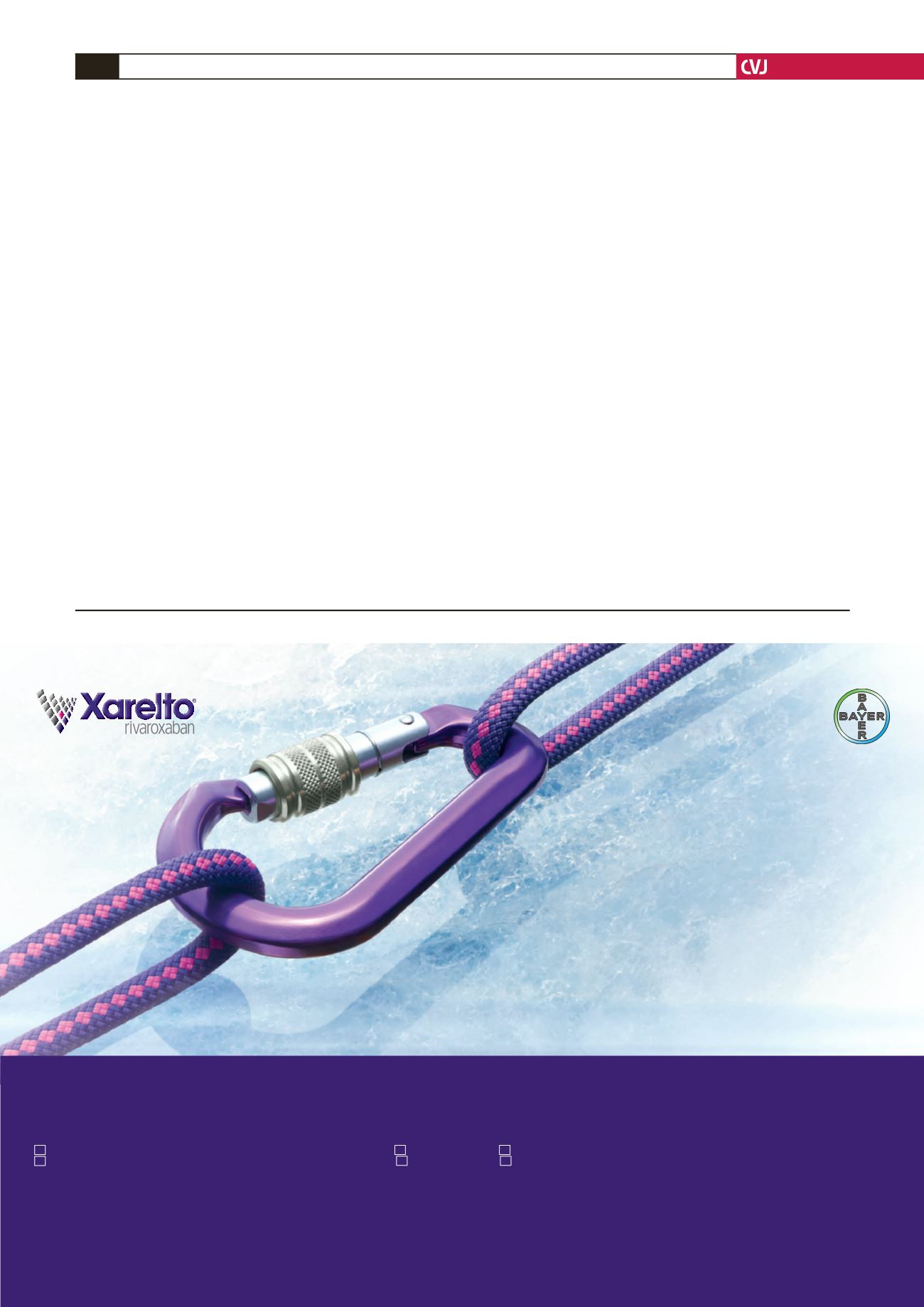

CARDIOVASCULAR JOURNAL OF AFRICA • Volume 28, No 3, May/June 2017
140
AFRICA
strategies and action plans to reduce exposure to patients and
staff should be followed.
11
Institutional insensitivity should also
be addressed and the proper fundamental principles of radiation
protection should be rigidly applied.
The profession shouldbe concernedabout how interventionists
and young cardiologists with long careers ahead of them can
avoid the ravages of exposure to ionising radiation. Over a
lifetime, how much radiation exposure is acceptable and how
much are we at risk of the complications of prolonged and
recurrent exposure? The time to act is now.
References
1.
IRPA guiding principles for establishing a radiation protection
culture. URL: http://
http://www.irpa.net/members/IRPA-Guiding%20Principles%20on%20RP%20Culture%20-2014%20.pdf.
2.
Vano E, Kleiman NJ, Duran A, Romano-Miller M, Rehani MM.
Radiation-associated lens opacities in catheterization personnel: results
of a survey and direct assessments.
J Vasc Interv Radiol
2013;
24
:
197–204.
3.
Roguin A, Goldstein J, Bar O. Brain tumours among interventional
cardiologists: a cause for alarm? Report of four new cases from two
cities and a review of the literature.
EuroIntervention
2012;
7
: 1081–1086.
4.
Roguin A, Goldstein J, Bar O. Brain malignancies and ionising radia-
tion: more cases reported.
EuroIntervention
2012;
8
: 169–170.
5.
Roguin A, Goldstein J, Bar O, Goldstein JA. Brain and neck tumors
among physicians performing interventional procedures.
Am J Cardiol
2013;
111
: 1368–1372.
6.
Picano E, Vano E, Domenici L,
et al
. Cancer and non-cancer brain
and eye effects of chronic low-dose ionizing radiation exposure.
BMC
Cancer
2012;
12
: 157.
7.
Marazziti D, Baroni S, Catena-Dell’Osso M,
et al
. Cognitive, psycho-
logical and psychiatric effects of ionizing radiation exposure.
Curr Med
Chem
2012;
19
: 1864–1869.
8.
Kumar G, Rab ST. Radiation safety for the interventional cardi-
ologist – a practical approach to protecting ourselves from the dangers
of ionizing radiation.
http://www.acc.org/latest-in-cardiology/arti-cles/2015/12/31/10/12/radiation-safety-for-the-interventional-cardiolo-
gist.
9.
Leyton F, Canevero L, Dourado A,
et al.
Radiation risks and the
importance of radiological protection in interventional cardiology: a
systematic review.
Rev Bras Cardiol Invasiva
2014;
22
: 87–98.
10. Rose A, Ray W. Perception of radiation safety training among interven-
tionalists in South Africa.
Cardiovasc J Afr
2017; 196–200.
11. Fazel R, Gerber TC, Balter S,
et al
. Approaches to enhancing radia-
tion safety in cardiovascular imaging. A scientific statement from the
American Heart Association. Intervention.
Circulation
2014;
130
:
1730–1734.
Confidence Through Clinical
and Real World Experience
1-3
Millions of Patients Treated Across Multiple Indications
4
#1 NOAC prescribed by Cardiologists
*
*Impact RX Data Oct - Dec 2015
NOAC: Non Vitamin K Oral Anticoagulant
REFERENCES: 1.
Patel M.R., Mahaffey K.W., Garg J.
et al.
Rivaroxaban versus warfarin in non-valvular atrial fi brillation.
N Engl J Med
. 2011;365(10):883–91.
2.
Tamayo S., Peacock W.F., Patel M.R.,
et al.
Characterizing major bleeding in patients
with nonvalvular atrial fi brillation: A pharmacovigilance study of 27 467 patients taking rivaroxaban.
Clin Cardiol
. 2015;38(2):63–8.
3.
Camm A.J., Amarenco P., Haas S.
et al.
XANTUS: A Real-World, Prospective, Observational Study.
4.
Calculation
based on IMS Health MIDAS, Database: Monthly Sales December 2015.
S4 XARELTO
®
15: Each film-coated tablet contains rivaroxaban 15 mg. Reg. No: 46/8.2/0111; Namibia S2 : 12/8.2/0006; Botswana S2 : BOT1302296
S4 XARELTO
®
20: Each film-coated tablet contains rivaroxaban 20 mg. Reg. No: 46/8.2/0112; Namibia S2 : 12/8.2/0007; Botswana S2 : BOT1302297
PHARMACOLOGICAL CLASSIFICATION:
A.8.2 Anticoagulants.
INDICATIONS:
(1) Prevention of stroke and systemic embolism in patients with non-valvular atrial fibrillation (SPAF); (2) Treatment of deep vein thrombosis (DVT) and for the prevention
of recurrent deep vein thrombosis (DVT) and pulmonary embolism (PE); (3) Treatment of pulmonary embolism (PE) and for the prevention of recurrent pulmonary embolism (PE) and deep vein thrombosis (DVT).
HCR:
Bayer (Pty) Ltd, Co. Reg. No.:
1968/011192/07, 27 Wrench Road, Isando, 1609. Tel: +27 (0) 11 921 5044 Fax: +27 (0) 11 921 5041. For full prescribing information, refer to the package insert approved by the Medicines Regulatory Authority (MCC).
L.ZA.MKT.GM.01.2016.1265
© Bayer January 2016

















